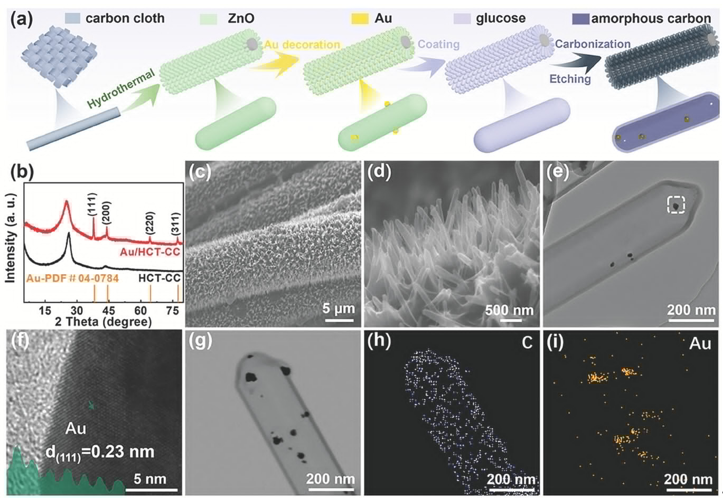ENG
★Lithium anode materials newsletter★
2024.01 Second issue
01
Silicon based anode materials
Article name: High-areal capacity Si architecture as an on-chip anode for lithium-ion batteries
Article Features:High-areal capacity Si architecture as an on-chip anode for lithium-ion batteries
Article Type: Article
Journal: Energy Storage Materials
DOI: 10.1016/j.ensm.2023.103172
Year: 2024-01
Correspondence should be addressed to: SOFIANE Abdelouhab, Denis Machon
Correspondence should be addressed to: University of Sherbrooke, Canada
Application areas: Lithium-ion batteries
Keywords: microbattery; lithium-ion battery; mesoporous silicon; on-chip anode
Article Summary:
Silicon is one of the most promising anode materials for lithium-ion batteries, especially in meeting the growing demand for energy storage in the form of miniature batteries for mobile and autonomous devices. However, the development of such batteries is hampered by mechanical and electrochemical failures caused by the volume expansion of silicon and the continuous growth of the solid electrolyte interface. In this study, a new on-chip anode structure is proposed on porous silicon treated using rapid thermal annealing. The structure consists of a dense silicon layer on top of an isotropic structure of porous layers. We demonstrate that this structure enhances electrochemical and mechanical stability, achieving an area capacity of 9 mAh cm-2 after more than 200 cycles and a Coulombic efficiency close to 100%.
Article Schematic

02
Silicon based anode materials
Article Name:Recycled solar-grade silicon kerf scraps and sandwiched by tunable porous carbon sheets as commercial anodes
Article Features:Recycled solar-grade silicon kerf scraps and sandwiched by tunable porous carbon sheets as commercial anodes
Article Type: Article
Journal:Journal of Energy Storage
DOI: 10.1016/j.est.2023.110164
Year:2024-01
Correspondence should be addressed to: JIAN Shi
Unit:Fuyang Normal University
Application:Lithium-ion batteries
Keywords: commercial lithium batteries; Si/C anode; tunable synthesis; solar-grade silicon chips; sheet CaCO3; sandwich-like porous structure
Article Summary:
In order for silicon/carbon (Si/C) anodes to be easily commercialized, solar-grade silicon scraps (SGSKS) discarded from the photovoltaic industry are purified and recycled as a cost-effective silicon source for lithium storage. However, the pursuit of good structural integrity and long-lasting lifetime is of more concern than the ultra-high capacity of commercial Si/C anodes due to the limitations of commercial cathodes, which are mainly influenced by the silicon mass fraction and volume expansion tolerance. Therefore, controlling the silicon mass loading and providing sufficient void space for volume expansion are important for high-quality Si/C anodes. Herein, the synthesis of a highly tunable porous carbon sheet (PCS/Si) sandwich Si/C composite is described using flake CaCO3 as a template and SGSKS as a raw material. By adjusting the mass ratio of CaCO3 to Si, the mass loading and voids of Si in PCS/Si can be effectively controlled to enhance the structural integrity and prolong the lifetime while obtaining sufficient capacity to meet the commercial demand. Experimental results show that benefiting from this careful design, the optimized PCS/Si-2 composite has a high capacity retention of 853.4 mAh g-1 at 0.2 A g-1 with a relatively good structural integrity at a silicon mass loading of 30.62 wt%. In addition, the full cell using a PCS/Si-2 anode matched with a commercial LiCO2 cathode exhibited a long cycle stable capacity of 103.4 mAh g-1 at 0.2 C, which could also illuminate a row of LED bulbs for several hours, thus facilitating the potential for commercial applications. Meanwhile, it provides another valuable perspective for the high-value recycling and reuse of photovoltaic waste to promote resource conservation and environmental protection.
Article Schematic
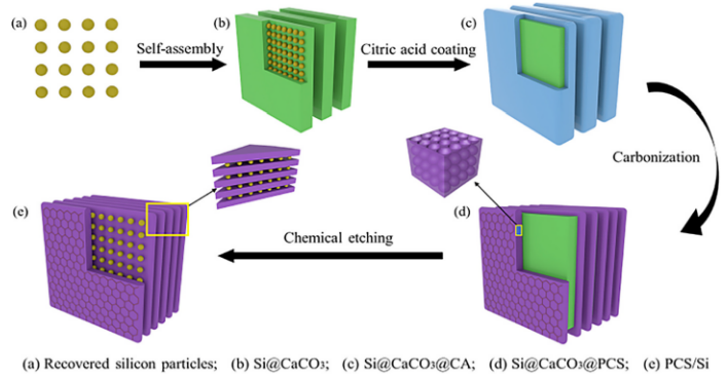
01
Hard Carbon Anode Materials
Article name: Regulating Graphitic Microcrystalline and Single-Atom Chemistry in Hard Carbon Enables High-Performance Potassium Storage
Article Features:Regulating Graphitic Microcrystalline and Single-Atom Chemistry in Hard Carbon Enables High-Performance Potassium Storage
Article Type: Article
Journal: Advanced Functional Materials
DOI: 10.1002/adfm.202309509
Year: 2023-12
Correspondence should be addressed to JIN Wang
Unit:Nanjing University of Technology
Application areas: Potassium ion batteries
Keywords: catalytic pyrolysis; hard carbon; potassium ion batteries; monatomic
Article Summary:
Hard carbon (HC) has emerged as the most promising anode for potassium ion batteries (PIBs) and has attracted considerable research interest due to its tunable interlayer spacing and abundant voids to accommodate K+. However, the low initial coulombic efficiency and high plateau potential of hard carbon have seriously hindered its practical application. In this paper, a manganese ion-catalyzed pyrolysis strategy is explored to modulate the graphite microcrystalline structure and local electron distribution in hard carbon, thereby greatly enhancing the K+ platform storage and ICE.Systematic experimental measurements, in situ/non-in situ observations, kinetic analyses, and density-functional theory calculations indicate that the introduction of Mn2+ ions catalyzes the formation of short-ordered graphite nano-domains in hard carbon, which provides abundant K+ insertion, and at the same time provides a high K+ potential through the Mn -N3-C coordination structure induces localized electron distribution, realizing the dynamic diffusion of K+ and electron transfer kinetics. As a result, the modulated hard carbon exhibits high low-potential plateau capacity, excellent rate capability, and high initial coulombic efficiency in the potassium half-cell structure. More importantly, an “adsorption-insertion” charge storage mechanism is proposed based on the correlation between the carbon structure and the discharge/charge platform. This work provides insights into the fundamentals of microstructure modulation of hard carbon anodes for high-performance PIBs.
Article Schematic
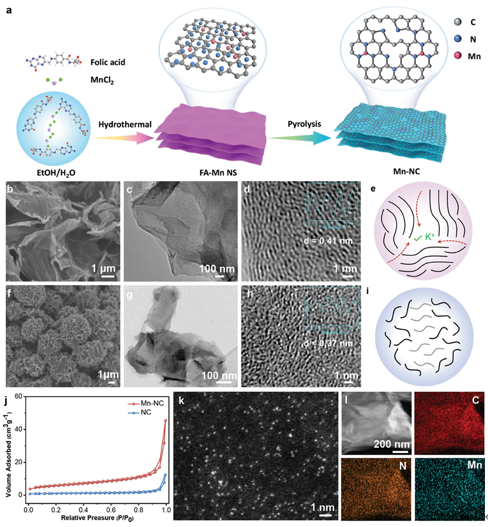
01
Fast charging anode materials
Article Name:Origin of fast charging in hard carbon anodes
Article Features:Origin of fast charging in hard carbon anodes
Article Type: Article
Journal: Nature Energy
DOI: 10.1038/s41560-023-01414-5
Year:2024-01
Correspondence should be addressed to YONG-SHENG HU
Unit:Institute of Physics, Chinese Academy of Sciences
Application Areas: Lithium/sodium ion batteries
Article Abstract:
The future development of electric vehicles and grid energy storage relies heavily on the fast-charging capability of lithium/sodium-ion batteries, but plating problems with graphite in anodes have prompted a scientific focus on anodes with constant storage potential. In this paper, we report that an all-sodium-ion battery based on a hard carbon anode at the ampere-hour level achieves 3,000 charge/discharge cycles in about 9 minutes. The hard carbon anode not only has a ramp segment voltage storage capacity, but is also able to provide capacity at high area capacity at a plateau segment slightly above the sodium metal precipitation potential with no sodium metal precipitation observed. This work also compares the electrochemical behaviors of Li and Na in hard carbon by experimental and computational techniques, and proposes a unified storage mechanism dependent on the size of the wedge-shaped nanopores, with a mechanism similar to the underpotential deposition of metals, which provides a reasonable guide to achieve fast storage in hard carbon anodes.
Article Schematic
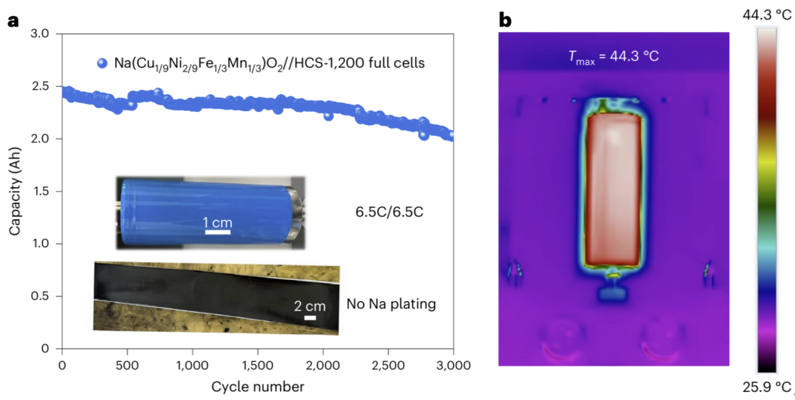
02
Fast charging anode materials
Article name: Surface chemistry induced robust SEI on graphite surface via soft carbon coating enables fast lithium storage
Article Features:Surface chemistry induced robust SEI on graphite surface via soft carbon coating enables fast lithium storage
Article Type: Article
Journal: Carbon
DOI: 10.1016/j.carbon.2023.118729
Year: 2023-12
Correspondence should be addressed to Jilei Liu, Zhiyong Wang, Peng Gao
Correspondence should be addressed to: Hunan University
Application areas: Lithium-ion batteries
Keywords: graphite anode; fast charging; carbon coating; electrode-electrolyte interface; lithium ion battery
Article Abstract:
Fast charging of lithium-ion batteries with long cycle life using graphite anodes is often hindered by the uncontrollable lithium plating on the graphite surface. In this paper, the effect of soft carbon coating on SEI performance and Li+ storage performance is systematically investigated. Various analytical studies combined with three-electrode impedance measurements and interfacial analyses show that the carbon coating effectively slows down the formation of a resistive film on the graphite surface, thereby facilitating charge transfer and low-energy barriers. Depth profiling XPS analysis clearly shows that the formation of uniform, robust and LiF-rich SEI plays a dominant role in enhancing interfacial dynamics, with Li+ diffusion in the bulk electrode being less affected. As a result, the graphite anode with carbon coating exhibits better fast charging performance and cycle life with 98.3% capacity retention after 100 cycles at 2C-CV. This work reveals the key role of coating chemistry in regulating SEI performance and Li+ storage performance, and provides valuable guidance for the rational design of practical fast-charging graphite anodes.
Article Schematic
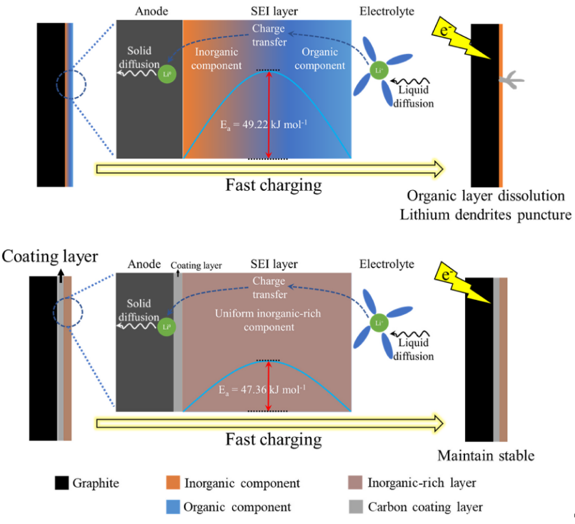
01
New Battery & Anode Materials
Article Name:Dual carbon confined MoS2 hierarchical microspheres as high-performance anode for sodium-ion batteries with superior cycling stability
Article Features:Dual carbon confined MoS2 hierarchical microspheres as high-performance anode for sodium-ion batteries with superior cycling stability
Article type: Article
Journal: Journal of Energy Storage
DOI: 10.1016/j.est.2023.109801
Year:2023-12
Correspondence should be addressed to: Guoquan Suo
Unit:Shaanxi University of Science and Technology
Application Areas: Sodium-ion batteries
Keywords: sodium ion battery; anode material; MoS2; carbon core-shell structure
Article Abstract:
Sodium-ion batteries (SIBs) have received much attention as potential energy storage devices for large-scale applications due to the growing demand in the energy market. However, slow kinetics and significant volume expansion during cycling lead to poor electrochemical behavior of SIBs. In this paper, a nanocomposite bicarbon material containing an internal hard carbon core and an external N-doped carbon shell constrained MoS2 layered microspheres (HC@MoS2@NC) is prepared as the anode of SIBs with excellent cycling stability and good multiplicity performance. Bicarbon confinement can improve the structural stability of MoS2. The double carbon has good electronic conductivity, which ensures the good cell multiplicity performance of the MoS2 anode. Meanwhile, the larger layer spacing of 10.09 Å due to NC insertion allows MoS2 to store more Na+. As a result, a high capacity of 321 mAh g-1 was provided at HC@MoS2@NC纳米复合材料在100次循环后在0.1 A g-1. At a high current density of 2 A g-1, a high capacity of 180 mAh g-1 is still achieved after 1000 cycles. Even at a high current density of 5 A g-1, the capacity is maintained at 162 mAh g-1 after 100 cycles.
Article Schematic
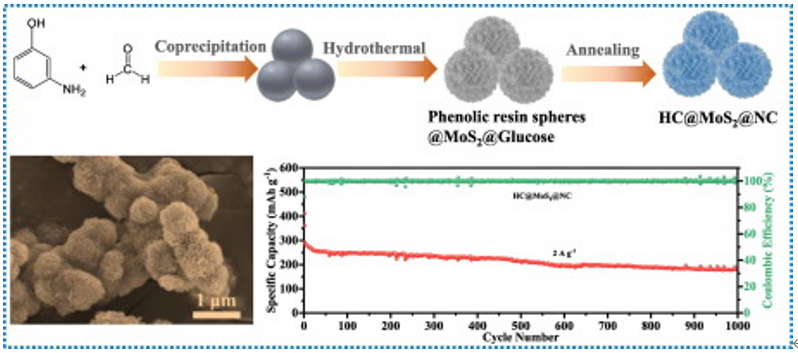
02
New Battery & Anode Materials
Article name: Self-Confinement of Na Metal Deposition in Hollow Carbon Tube Arrays for Ultrastable and High-Power Sodium Metal Batteries
Article Features:Self-Confinement of Na Metal Deposition in Hollow Carbon Tube Arrays for Ultrastable and High-Power Sodium Metal Batteries
Article Type: Article
Journal: Advanced Functional Materials
DOI: 10.1002/adfm.202312750
Year:2024-01
Correspondence should be addressed to ZHENG-LONG Xu
Correspondence should be addressed to ZHENG ZHOU UNIVERSITY Applications: Sodium metal batteries
Keywords: Au/HCT-CC; dendrite-free; in situ transmission electron microscopy; sodium metal anode; theoretical simulation
Article Abstract:
Sodium-metal batteries are expected to be the next generation of energy storage technology, which use energy-dense and affordable sodium metal as the anode, but face the problem of uncontrollable sodium dendrite growth. In this paper, gold nanoparticles@hollow amorphous carbon tube/shell arrays (Au/HCT-CC) are rationally designed as dynamic hosts on carbon cloth. In situ transmission electron microscopy observations reveal regulated dendrite-free Na metal plating/exfoliation within the Au/HCT-CC hosts. Experimental and theoretical characterization demonstrated that self-restraint of Na metal deposition in hollow carbon could further stabilize the electrolyte/electrode interface and homogenize the sodium ion flux, thus successfully overcoming the barrier of the Na metal anode. When cycled in a half-cell, the Au/HCT-CC electrode provides up to 99.96% Coulombic efficiency (CE) at 5 mA cm-2 current for 2200 hours. The high CE of 99.54% was maintained even after 250 cycles under harsh cycling conditions of 10 mA cm-2 and 20 mAh cm-2. These values are comparable to the electrochemical performance of sodium metal anodes that have been presented in the literature. Finally, the practical feasibility of the new anode was demonstrated by cycling the Na3V2(PO4)3@C||Na-Au/HCT-CC full cell for more than 900 cycles with a very low capacity decay rate (0.017% per cycle).
Article Schematic
